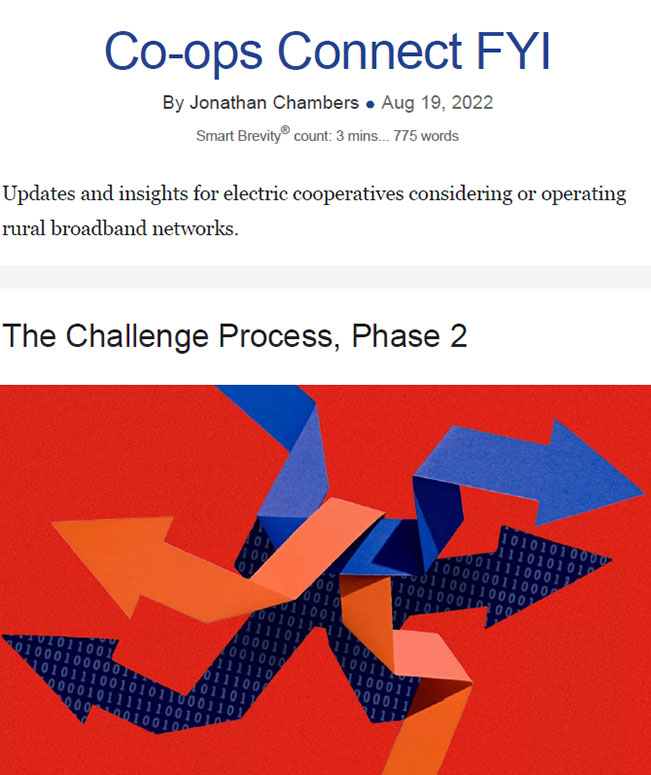The Challenge Process, Phase 2
August 19, 2022
- First, a recap: (see August 5 and August 12 editions)
1. The FCC is creating new broadband maps, which will be used to determine how $42.5 billion in federal broadband funding will be spent.
2. The FCC’s approach is to map every broadband serviceable location across the country, creating a Broadband Location Fabric.
3. The Fabric is currently being used by Internet Service Providers (ISPs) to report where service is available.
4. ISPs are required to submit files of technology type, speed, latency, and other network information in far more detail than in past reporting.
Why it matters:
In past FCC maps, any census block where no ISP has claimed the availability of 25/3 Mbps service was considered unserved.
With the new maps, any location identified in the Fabric where no ISP has claimed the availability of 25/3 Mbps service will be considered unserved.
- The count of unserved locations in a state will be used by NTIA to calculate the allocation of BEAD program funding for each state.
- Any location where no ISP has claimed the availability of 100/20 Mbps service will be considered underserved.
- Only unserved and underserved areas are eligible for BEAD funding.
- But that determination is left to states, which may use the FCC’s maps or maps of their own.
What’s next:
Both the locations and the claims of service will be subject to challenge, perhaps as early as this year but more likely in the first quarter of 2023.
The Speed Disconnect: Theoretically Available or Actually Available
The FCC’s data request of ISPs is more granular than in the past.
- The FCC has also attempted to cabin the speeds reported by certain technologies.
By the numbers:
DSL
- Companies using Digital Subscriber Line (DSL) technology cannot report coverage that exceeds 6,600 route feet from the digital subscriber line access multiplexer (DSLAM) to the customer premises for speeds offered at or above 25/3 Mbps.
- In other words, locations within 6,600 feet of a DSLAM will be considered served, albeit underserved.
- This is critical for the NTIA broadband allocation.
Cable
- Companies using Hybrid Fiber Coaxial (HFC) Cable technology shall not report coverage that exceeds 12,000 route feet from the aggregation point to the customer premises.
Fiber
- Companies using Fiber to the Premises (FTTP) technology shall not report coverage that exceeds 196,000 route feet from the optical line termination point to the optical network termination point.
Fixed wireless
- Companies that submit coverage maps shall submit propagation maps and propagation model details based on the following parameters:
(A) A cell edge probability of not less than 75% of receiving the maximum advertised download and upload speeds
(B) A cell loading factor of not less than 50%
(C) Receiver heights within a range of 4-7 meters
- Fixed wireless providers must also provide the FCC with information that includes frequency bands, carrier aggregation, radio technology, terrain and clutter information.
The Speed Challenge
I don’t expect the most critical data needed to review and challenge ISP submissions to be made public.
- Such data would include the locations of DSLAMs, cable aggregation points, and fixed wireless propagation models.
I don’t expect the FCC will put much stock in speed tests in the challenges.
I do expect numerous, time-consuming challenges because there is funding and competition at stake.
- But the burden will be on the challenger to disprove ISP claims.
I expect most of the challenges to the data provided will be related to the availability of BEAD funds, which translates into:
1. Are locations within 6,600 route feet of DSLAMs receiving 25/3 Mbps?
(Hint: Probably not.)
2. Do cable systems in rural areas consistently deliver 20 Mbps upstream?
(Hint: Also no.)
3. Do fixed wireless network propagation maps accurately reflect delivery of 100 Mbps upstream and 20 Mbps downstream?
(Hint: Of course not.)
The Big Picture
I believe the FCC’s new maps have the potential of greater accuracy and consistency than any broadband map previously published. More accurate than previous federal maps and any current state map.
Yes, but:
- There will be inconsistencies between the FCC map and state maps.
- The disputes between the federal and state maps will be more prominent as mapping consultant Lightbox (which bid, lost, and protested the FCC’s choice of consultants) is pitching itself to states as an alternative to the FCC’s maps.
The bottom line:
The FCC maps will be used to determine how much funding is allocated to each state.
- Thus, there is an incentive for states to challenge the maps.
- Since Texas, Alabama, Montana, and Georgia have chosen Lightbox, broadband maps could become political. (Yay?)
